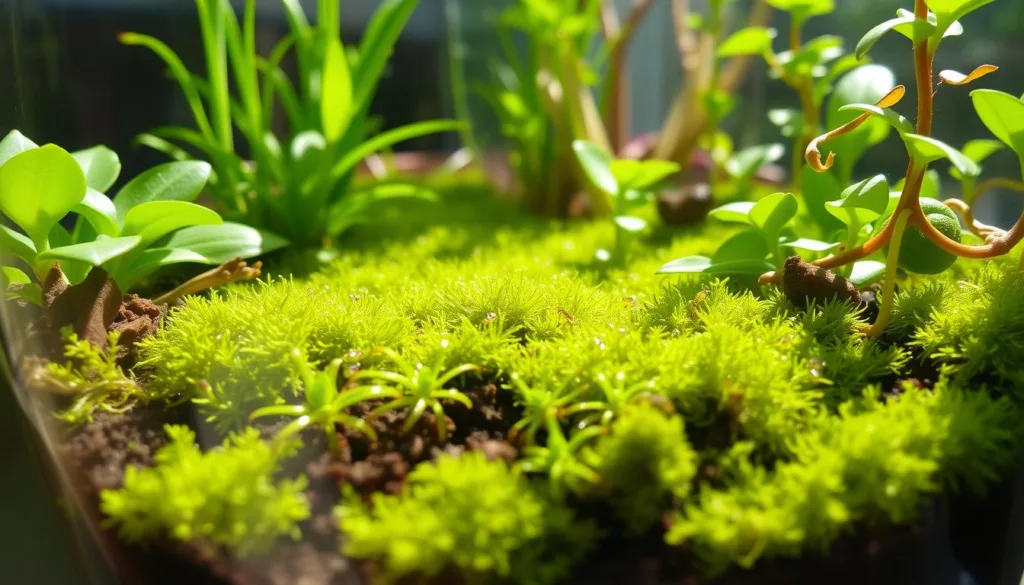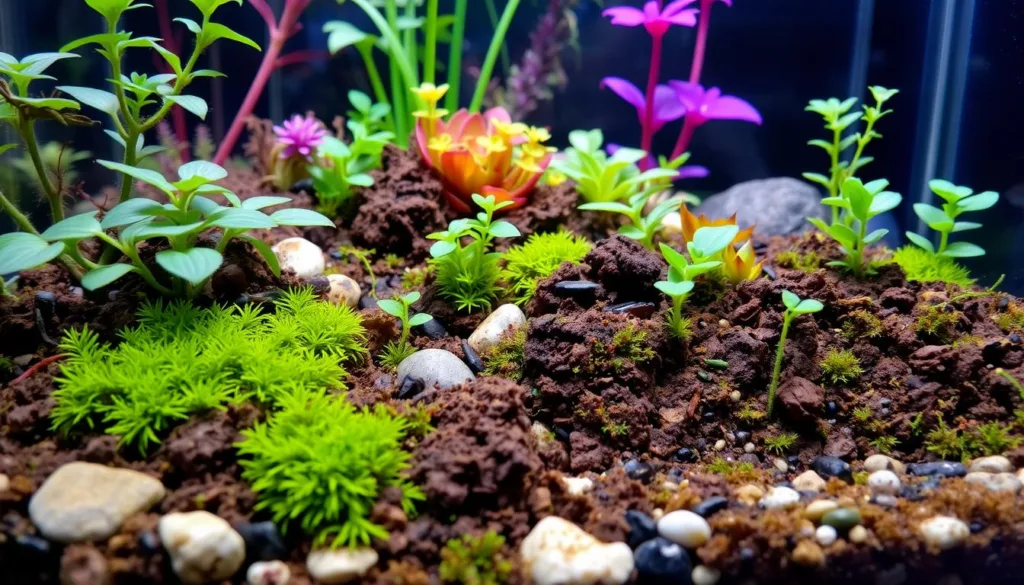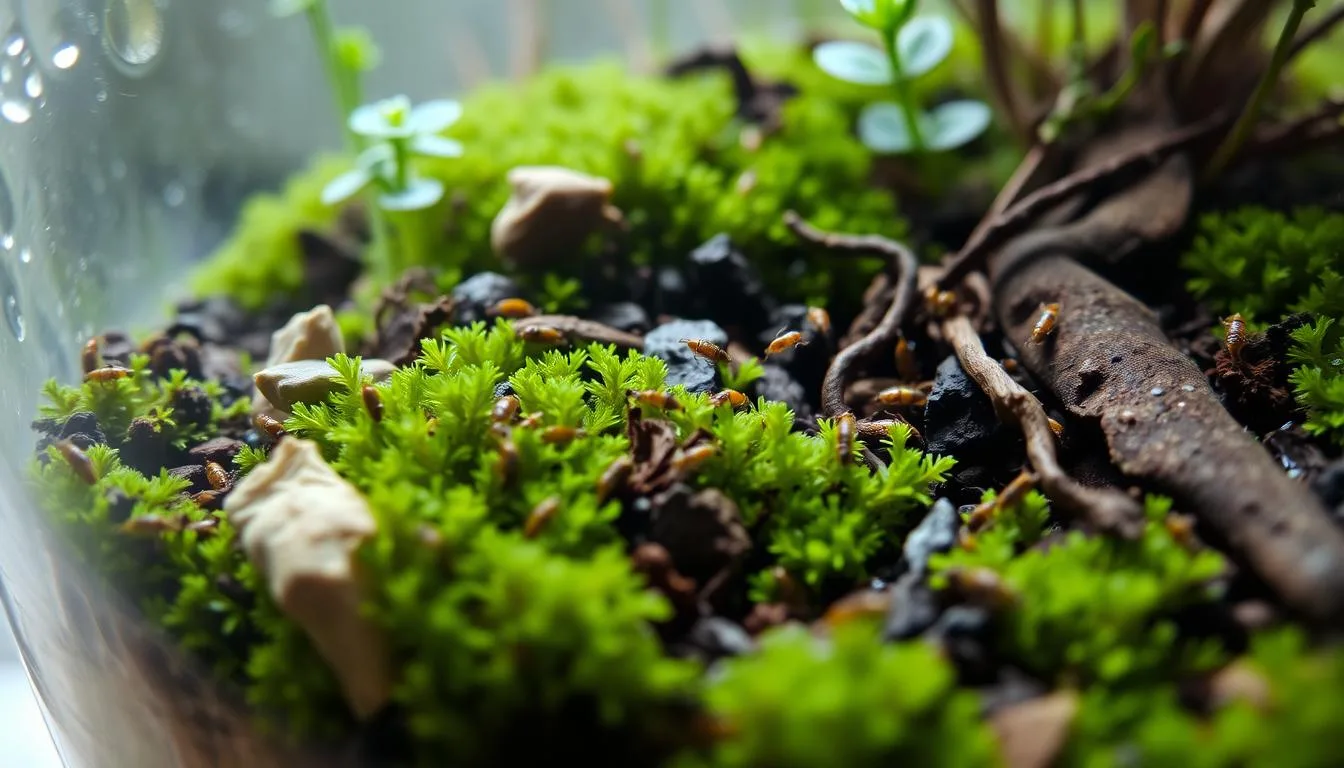Do you need Springtails in your terrarium? Can a tiny creature, often no bigger than a grain of sand, make a big difference in your terrarium? The answer might surprise you. Springtails, a group of versatile arthropods, are key to keeping terrariums healthy. They help control mold, manage nutrients, and support plant and animal life.
Key Takeaways
- Springtails are essential for maintaining a healthy terrarium ecosystem by consuming mold and decomposing organic matter
- With over 3,600 species worldwide, springtails are versatile creatures that can adapt to a wide range of climates and terrarium conditions
- Springtails self-regulate their population size based on the available food supply, making them an efficient and low-maintenance addition to your terrarium
- Springtails play a unique role in the pollination of moss, aiding in the spread and growth of these important terrarium plants
- Incorporating a starter culture of springtails is a recommended practice for most terrarium setups to ensure a thriving, balanced ecosystem
Understanding Springtails: Not Your Average Terrarium Inhabitants
Springtails are often ignored in terrariums, but they’re crucial. These tiny creatures help keep the terrarium balanced. Let’s explore their unique traits, evolution, and common myths to see why they’re important.
What Makes Springtails Unique
Springtails are not insects but hexapods, a group of small, wingless arthropods. They have internal mouthparts and a special jumping appendage called a furca. This lets them jump with great agility. They eat decaying matter, fungi, and bacteria, making them key decomposers in terrariums.
The Evolution and History of Springtails
Springtails are among the oldest land creatures, with a history over 410 million years old. They evolved from sea-dwelling arthropods and now live in many places. Their long history and adaptability make them common in soil and leaf litter.
Common Misconceptions About Springtails
Many people think springtails are pests or harmful, but they’re not. They don’t bite, sting, or infest homes. Their presence in terrariums shows a healthy ecosystem, as they help keep it balanced.
Understanding springtails’ unique traits, history, and myths helps us see their importance in terrariums. As you explore terrariums, remember how many springtails do i need in my terrarium and are springtails good for a terrarium are key to a thriving indoor garden.
The Role of Springtails in Terrarium Ecosystems
Springtails are more than just cute creatures in your terrarium. They are key to a healthy, balanced ecosystem. With over 3,600 species, they are among the oldest living creatures on land, dating back 410 million years.
In just one square meter of earth, over 100,000 springtails can live. In a terrarium, they help keep everything in balance. These tiny beings, less than 3 millimeters long, are crucial for the terrarium’s health.
Springtails like Folsomia candida love humid places like closed terrariums. They thrive in moist soil mixes, eating nutrients and helping plants grow.
They help break down organic matter, recycling nutrients for plants. This process supports plant growth and health. They even spread moss, helping it grow.
Springtails also fight mold and fungus in terrariums. They eat decaying plants and fungi, keeping the ecosystem balanced. This keeps plants healthy and looking great.
To keep a terrarium thriving, manage springtail numbers well. Keep humidity at 80-85% and use nutrient-rich soil. These tiny creatures are essential for a balanced, thriving terrarium.
Benefits of Springtails in Terrarium
Springtails are small, versatile creatures that offer many benefits for terrarium lovers. They play a key role in keeping your terrarium healthy and balanced. This is true for both closed and open terrariums.
Mold Control and Prevention
One big advantage of springtails in terrariums is their mold control. These tiny creatures are less than 6mm and eat fungi, decaying plants, and mold. They help keep your terrarium mold-free naturally.
Nutrient Cycling in Closed Systems
In closed terrariums, springtails help with nutrient cycling. They break down organic matter and their waste, called frass, is full of nutrients. These nutrients help plants grow and stay healthy.
Natural Plant Health Support
Springtails also support plant health in terrariums. They aerate the soil and break down decaying matter. This can help prevent root rot and other plant problems, creating a thriving environment.
Springtails are beneficial in terrariums of all sizes. Small terrariums (under 1 L) need 10-15 springtails. Medium terrariums (1-20 L) do well with 20-30 springtails. Large terrariums (over 20 L) can have 40-50 or more springtails for a balanced ecosystem.
Springtails work well in both closed and open terrariums, as long as it’s moist. Knowing their life cycle and population dynamics is key to their success in your terrarium.
Springtails in Terrarium: Setup and Introduction Methods
Adding springtails to your terrarium is easy. Just one starter culture can start a big colony. To move them, flip their container and tap them onto the substrate. Or, use a little water to “wash” them in.
For an easier way, use calcium-bearing clay or charcoal. This makes it simple to scoop them into your terrarium. Remember, springtails might need extra food in new terrariums until the plants break down.
| Optimal Conditions for Thai Red Springtails | Ideal Ranges |
|---|---|
| Temperature | 70-80°F (21-27°C) |
| Relative Humidity | 70-80% |
| Reproduction Rate | Up to 100 offspring per female |
| Decomposition Contribution | Aids in breaking down organic matter |
Keeping the terrarium moist is key for springtails. Mist it regularly to keep humidity right. Adding sphagnum moss helps keep it moist, giving springtails the water they need.
“Proper ventilation is crucial to prevent mold growth, with options such as mesh lids or small ventilation holes being recommended.”
By following these steps, you can introduce and grow a healthy springtail population. This will help keep your terrarium balanced and healthy.
Population Management and Self-Regulation
Keeping a terrarium healthy means watching the springtail population closely. Springtails can control their numbers based on food availability. They eat decaying organic matter and grow when there’s plenty of it.
Natural Population Control
Springtails live short lives, from weeks to months. This fast turnover keeps the terrarium’s ecosystem balanced. When food runs low, springtail numbers drop, preventing them from taking over.
Factors Affecting The Colony Size of Springtails In Terrarium
- Moisture levels: Springtails need humidity to thrive. Keeping the right moisture balance is key.
- Temperature: Warmer temps speed up springtail growth. Cooler temps slow them down.
- Organic matter availability: The terrarium’s organic matter affects springtail numbers. It’s their main food.
To keep springtail numbers in check, avoid overfeeding and too much organic matter. Finding the right balance is crucial for a healthy terrarium.
“Springtails offer a versatile protein source for terrarium inhabitants such as reptiles, vampire crabs, and certain frog species.”
Understanding how springtails manage their numbers helps create a balanced terrarium. This supports the health of all terrarium inhabitants.
Maintaining Proper Conditions for Springtail Health
To keep your springtails terrarium thriving, it’s key to provide the right conditions. Springtails love a moist, humid place to live. Whether your terrarium is closed or open, keeping the right moisture is vital for their health.
Springtails need a moist substrate, with humidity between 70-90%. In closed terrariums, moisture stays balanced naturally. But in open ones, misting regularly is needed to keep it moist. Don’t let the substrate dry out, as it can harm your springtail colony.
When it comes to temperature, springtails do best between 70-75°F (21-24°C). They can handle a bit of variation, but this range is best for them. Avoid sudden temperature changes, as they can stress the springtails and slow their growth.
Remember, how to keep springtails alive in terrarium is about finding the right balance. Too much food or organic matter can cause mold and harm your springtails. Keep the substrate clean and well-aired, and avoid debris. By doing this, you can have a healthy, thriving springtail population in your terrarium.

Springtails are fascinating and play a crucial role in terrarium ecosystems. By understanding their needs and creating the perfect environment, you can enjoy their benefits. This way, you can keep your terrarium healthy and balanced for many years.
Compatibility with Different Terrarium Types
Introducing springtails to your terrarium depends on your setup. They love the humid, moist environments of closed terrariums. But, they can also do well in open terrariums if you keep the moisture right.
Closed vs. Open Terrariums
Closed terrariums are perfect for springtails because they’re so humid. The sealed setup keeps moisture in, making it ideal for these tiny creatures. Open terrariums need more care to keep the moisture just right for springtails.
Bioactive Setup Considerations
Springtails and isopods are a great team in bioactive terrariums. Springtails eat decaying matter and fungi, while isopods handle bigger pieces. This teamwork keeps the terrarium clean and healthy.
In arid terrariums, like desert ones, there are special springtail species. The Temperate White Springtail (Folsomia candida) is one example. These springtails can handle the dry conditions of desert terrariums.
When choosing springtails for your terrarium, think about what your setup needs. Knowing which terrarium type springtails fit best helps create a balanced, thriving indoor space.
Springtails In Terrarium: Common Challenges and Solutions
Keeping springtails alive in your terrarium can be tricky. But, with the right steps, you can make sure they stay happy and healthy. Let’s look at some common problems and how to solve them.
One big worry is population fluctuations. Springtails can be sensitive to their surroundings. Their numbers might change suddenly. This is normal, but to keep them stable, make sure the substrate is just right and don’t overfeed.
It’s also hard to tell if your springtails are doing well. They’re tiny, so it’s hard to see if they’re healthy or not. Watch for signs of dryness, especially in open terrariums. If they seem to disappear, they might be hiding in the substrate to find moisture.
- Check the substrate moisture often and adjust it to keep it perfect.
- Don’t overfeed, as it can upset the balance of your terrarium.
- If springtails seem to vanish, they might be hiding in the substrate. Gently dig into the soil to find them.
By tackling these common issues and following good terrarium care, you can make sure your springtails thrive. They will keep your terrarium balanced and fascinating.

“Springtails are the unsung heroes of the terrarium world, quietly working to keep your miniature ecosystem in balance.”
Best Practices for Long-term Success
To keep your springtails thriving in your terrarium, you need to balance moisture, feeding, and monitoring. These steps will help your springtails and terrarium stay healthy for a long time.
Moisture Management
Springtails love moist environments. But, too much water can cause mold. Keep the substrate damp but not soggy by misting it often. Watch the moisture levels and adjust as needed to keep your springtails happy.
Feeding Guidelines
Springtails eat decaying matter. You can add food like powdered fish flakes or crushed eggshells. But, don’t overfeed to avoid mold. Start with small amounts and see how your springtails react to find the right feeding schedule.
Monitoring Tips
Check your terrarium often for signs of springtail activity and health. Look for a lively springtail population and any changes in their behavior. Also, watch for mold or other problems. This way, you can fix issues quickly and keep your terrarium perfect for springtails.
With the right moisture, feeding, and monitoring, your springtails can thrive in your terrarium for years. Follow these tips to keep your springtails happy and healthy in their new home.
| Key Considerations | Recommendations |
|---|---|
| Moisture Level | Maintain a damp, but not waterlogged, substrate |
| Feeding | Provide small amounts of powdered fish flakes, crushed eggshells, or vegetable scraps |
| Monitoring | Regularly inspect the terrarium for signs of springtail activity and overall ecosystem health |
By following these best practices, you can keep your springtails alive and thriving in your terrarium. This will ensure a balanced and healthy terrarium ecosystem for years to come.
Conclusion
Springtails are key players in terrariums, helping with mold control, nutrient cycling, and keeping the ecosystem balanced. They are easy to care for, making them great for both new and seasoned terrarium springtails fans. By knowing their needs and benefits, you can build a thriving, easy-to-maintain springtails in terrarium world. This world shows the beauty of nature in a small space.
Springtails come in over 3,600 species and can number in the tens of thousands per square meter of earth. These tiny creatures are crucial in the natural world. They can live in places as cold as Antarctica or as dark as caves, making them perfect for your terrarium.
Starting your terrarium journey? Remember, springtails are more than just decorations. They actively help keep your terrarium healthy and lively. With the right setup, you can create a self-sustaining community. This community will keep your terrarium clean, full of nutrients, and beautiful for years.

